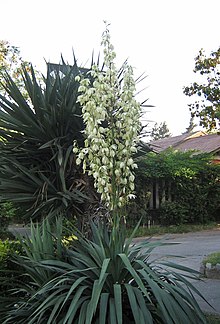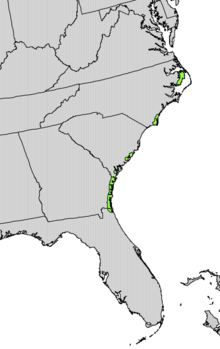Loading AI tools
Species of shrub From Wikipedia, the free encyclopedia
Yucca gloriosa is a species of flowering plant in the family Asparagaceae, native to the southeastern United States. Growing to 2.5 m (8 ft), it is an evergreen shrub. It is widely cultivated as an ornamental for its architectural qualities, and has reportedly become established in warmer climates in the wild in various parts of the world.
| Yucca gloriosa | |
|---|---|
 | |
| Scientific classification | |
| Kingdom: | Plantae |
| Clade: | Tracheophytes |
| Clade: | Angiosperms |
| Clade: | Monocots |
| Order: | Asparagales |
| Family: | Asparagaceae |
| Subfamily: | Agavoideae |
| Genus: | Yucca |
| Species: | Y. gloriosa |
| Binomial name | |
| Yucca gloriosa | |
 | |
| Natural range | |
| Synonyms[1] | |
|
Species synonymy
| |

Common names include:-
Yucca gloriosa is caulescent, usually with several stems arising from the base, the base thickening in adult specimens. The long narrow leaves are straight and very stiff, growing to 30–50 cm (12–20 in) long and 2–3.5 cm (3⁄4–1+1⁄2 in) wide. They are dark green with entire margins, smooth, rarely finely denticulate, acuminate, with a sharp brown terminal spine. The inflorescence is a panicle up to 2.5 m (8 ft) long, of bell-shaped white flowers, sometimes tinged purple or red. The fruit is a leathery, elongate berry up to 8 cm (3 in) long.[3][4][5][6][7]
Yucca gloriosa was first described by Carl Linnaeus in 1753.[8] Genetic evidence has shown that the species originated via multiple hybridizations between Yucca aloifolia and Yucca filamentosa.[9]
Yucca gloriosa grows on exposed sand dunes along the coast and barrier islands of the subtropical southeastern USA, often together with Yucca aloifolia and a variety formerly called Yucca recurvifolia or Y. gloriosa var. recurvifolia, now Y. gloriosa var. tristis.[10] In contrast to Y. gloriosa var. tristis, the leaves of Y. gloriosa var. gloriosa are hard stiff, erect and narrower. On the other hand, Y. aloifolia has leaves with denticulate margins and a sharp-pointed, terminal spine.
Yucca gloriosa is native to the coast and barrier islands of southeastern North America, growing on sand dunes. It ranges from extreme southeastern Virginia south to northern Florida in the United States. It is associated with Yucca filamentosa, Yucca aloifolia, and Opuntia species.
The plant is widely cultivated in warm temperate and subtropical climates, and valued as an architectural focal point. It has reportedly escaped from cultivation and naturalised in Italy, Turkey, Mauritius, Réunion, Guam, the Northern Mariana Islands, Puerto Rico, Argentina, Chile and Uruguay.[11] In landscape use, little maintenance is needed other than the removal of dead leaves when the shrub nears its ultimate height. The plant is very hardy, without leaf damage at −20 °C (−4 °F), and can handle brief snow and freezing temperatures, as well as long periods of drought. [12]
Yucca gloriosa,[13] and the cultivars 'Variegata'[14] and Bright Star = ‘Walbristar’[15] have gained the Royal Horticultural Society's Award of Garden Merit.[16]
Yucca gloriosa has been known to cause skin irritation and even allergic reactions upon contact. The leaf points are even sharp enough to break the skin.[17]
In collections in Europe and overseas, there are many forms and hybrids (Sprenger, Förster) from the 18th and 19th centuries. The following names have been used for material of uncertain origin in the European garden flora.
Seamless Wikipedia browsing. On steroids.
Every time you click a link to Wikipedia, Wiktionary or Wikiquote in your browser's search results, it will show the modern Wikiwand interface.
Wikiwand extension is a five stars, simple, with minimum permission required to keep your browsing private, safe and transparent.